Bird watching in Almeria
Almeria - Andalucia - Southern Spain
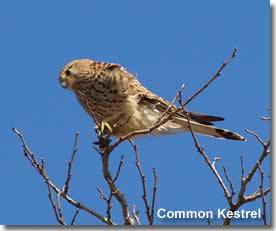 A unique ornithological paradise, the geological location, climate and varied landscapes of Almeria contribute to the impressive abundance of bird life. Birds of prey such as Bonelli's Eagle and the Common Kestrel can be seen around the mountain ranges, while the coastal lagoons harbour Grey and Purple Heron, Storks, Cranes, Avocets, Plovers, Waders and Ducks and the rare Dupont's Lark. Sea bird species include Yellow-legged Gulls, Terns, Razorbills, Shags, and the occasional Puffin. A main migration route between Europe and Africa, Almeria offers bird watching enthusiasts an amazing array of migratory birds including the Greater Flamingo, though these visitors are best spotted in certain months of the year.
A unique ornithological paradise, the geological location, climate and varied landscapes of Almeria contribute to the impressive abundance of bird life. Birds of prey such as Bonelli's Eagle and the Common Kestrel can be seen around the mountain ranges, while the coastal lagoons harbour Grey and Purple Heron, Storks, Cranes, Avocets, Plovers, Waders and Ducks and the rare Dupont's Lark. Sea bird species include Yellow-legged Gulls, Terns, Razorbills, Shags, and the occasional Puffin. A main migration route between Europe and Africa, Almeria offers bird watching enthusiasts an amazing array of migratory birds including the Greater Flamingo, though these visitors are best spotted in certain months of the year.
Quick links to bird watching destinations in Almeria:
- Cabo de Gata Natural Park including the Las Salinas de Cabo de Gata wetlands
- Punta Entinas - Sabinar nature reserve - Almerimar - Roquetas de Mar
- Albufera nature reserve -Adra
Almeria province is home to a range of diverse environments with varying vegetation, besides the significant coastal wetlands, the region includes desert plains, extensive mountain ranges, woodland forests, and rugged shorelines, many areas have special protection in place to preserve their natural state, ensuring the conservation of the habitats and encouraging much bird activity.
Choose Almeria for bird watching holidays in Spain...
Almeria bird watching holidays, unique bird spotting locations and destinations...
Bird spotting destinations in Almeria
Bird watching - Cabo de Gata Natural Park - Las Salinas
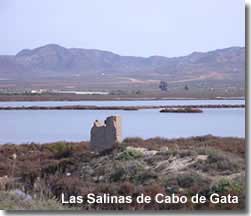 The protected salt flats of the Cabo de Gata Natural Park in Almeria provide a very important haven for both resident and migrating birds.
The protected salt flats of the Cabo de Gata Natural Park in Almeria provide a very important haven for both resident and migrating birds.
The wetland area runs parallel to the beach of San Miguel de Cabo de Gata, along the southern shoreline of the park, separated from it by the ALP-822 coastal highway.
An all year round destination for bird watching, in the summertime the Las Salinas receives a large influx of migrating Flamingos.
Las Salinas Habitats
The salt mining facility at Las Salinas offers a prime example of human intervention 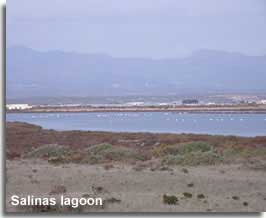 working with nature, the essence of Las Salinas as a feeding ground for bird life revolves around the water levels of the lagoons, regulated throughout the year, with assistance when necessary in the dry summer months, ensures a summertime food source when other locations in Andalucia are all dried up.
working with nature, the essence of Las Salinas as a feeding ground for bird life revolves around the water levels of the lagoons, regulated throughout the year, with assistance when necessary in the dry summer months, ensures a summertime food source when other locations in Andalucia are all dried up.
The edges of the salt pans allow dense reed beds and tamarisks to become established, making ideal nesting places for several types of bird.
The coastal steppe accounts for most of the natural vegetation growth of this arid area and as a result most of the plants that grow here are well adapted to the dry 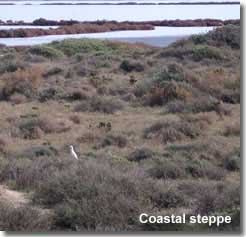 climate and stony soil. The bird life of the steppe, accommodating to this environment, tend to be discreet in colour so as to pass unnoticed where sparce plant cover fails to offer much protection. Their songs are varied allowing for different species to be recognised. The most common species on the coastal steppe is the Lesser Short-toed Lark, with the Greater Short-toed Lark locally abundant in the more inland territories. Stone Curlews and the Black-bellied Sandgrouse are regulars in the steppe along with the shy Dupont's Lark and the African Trumpeter Finch, which can only be found nesting in the south eastern area of the Iberian peninsula.
climate and stony soil. The bird life of the steppe, accommodating to this environment, tend to be discreet in colour so as to pass unnoticed where sparce plant cover fails to offer much protection. Their songs are varied allowing for different species to be recognised. The most common species on the coastal steppe is the Lesser Short-toed Lark, with the Greater Short-toed Lark locally abundant in the more inland territories. Stone Curlews and the Black-bellied Sandgrouse are regulars in the steppe along with the shy Dupont's Lark and the African Trumpeter Finch, which can only be found nesting in the south eastern area of the Iberian peninsula. 
The Flamingos
Las Salinas is visited by a wide variety of migrating bird species, however it is the sojourn of Greater Flamingo for which the lagoons have become most well known.
Flamingos are always on the move, after their winter stay in Doñana or Africa they move on to their breeding grounds, mainly in the French Camargue, in springtime the salt marshes present a welcome stop off point for the Flamingos, a place to feed and rest before their onward journey.
In the summer months the lagoons at Las Salinas provide enough water and associated micro fauna to tempt the Flamingos back from their breeding grounds, which by now are all but evaporated from the summertime heat, they concentrate in large numbers to feed after travelling not just from the Camargue but from all over Andalucia.
In the autumn and winter seasons the quantity of Flamingos falls considerably, as they fly off to warmer climates for the winter. The cycle begins again the following spring.
Seasons and bird spotting
Spring in the salt flats is a good season for bird spotting, resident birds, including the Kentish Plover and the Avocet, start their courtship rituals and begin their nest building, while spring migrants such as the Grey Heron and Little Egret can be spotted as they travel from Africa to their breeding grounds.
In the summertime vast numbers of both sedentary and summer visitors gather in the salt pans, essentially they are there for the same reasons as the Flamingos, the pools still have water and abundant food. Summer is a fascinating time of year, the spring chicks have now been raised and as young adults, offering a different plumage from their parents, they are at a crucial stage of their upbringing as they learn to fend for themselves. 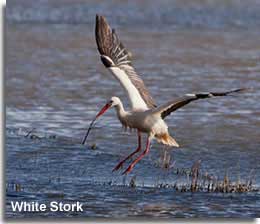
Autumn is perhaps the best period for observations in the Cabo de Gata wetlands, a time when many birds of passage are present, the White Stork, Common Redshank, Common Sandpiper and the Turnstone can all be seen as they make their way from breeding grounds to winter quarters. Birds that have spent the summer here will often join the migrations, heading south to warmer climates.
Winter visitors to Las Salinas join the resident bird life after migrating from northern Europe, they include the Dunlin, Audouin's Gull, the Oyster Catcher and the Common Shelduck.
The Amoladeras Visitors Centre, the main information centre for the natural park, provides information on Las Salinas salt pans and the bird species of the Cabo de Gata, in both Spanish and English, and includes interesting interactive displays. The centre is situated on the ALP-822, between Pujaire and Retamar, approximately fifteen minutes drive from Las Salinas. 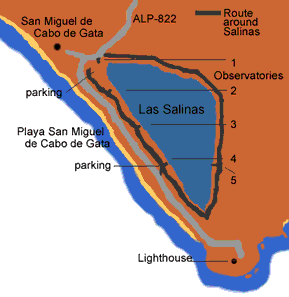
Las Salinas Observatories
- Observatorio de Uso Publico - Public Observatory
There are five observatories strategically positioned along the perimeter of Las Salinas, all are freely available for public use and provide close viewing in different spots on the edge of the saltwater lagoons. Four of these hides are situated by the side of a designated pathway that takes a route around the wetlands, and while this trail is closed to vehicles, there are options to access two of these observatories from the main ALP-822 highway.
It is possible to drive right up to the first observatory, it is situated by the side of the road before reaching the town of San Miguel de Cabo de Gata, with a small parking area directly in front of it, this is an easy to reach spot to get a good look at the lagoons. There is a telescope for enhanced sightings, a sheltered wooden bird watching hut, and an informational placard detailing some of the bird and plant species to be found.
The second and fourth observatories 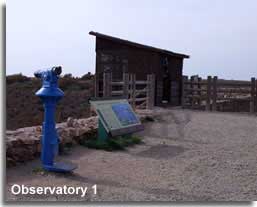 are signposted from the coastal highway, both can be reached by a short walk along unmade tracks, at number two there is no parking except by the side of the road, though observatory number four has space for parking off the main road close to the hide.
are signposted from the coastal highway, both can be reached by a short walk along unmade tracks, at number two there is no parking except by the side of the road, though observatory number four has space for parking off the main road close to the hide.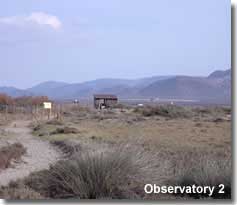 All the viewing points include wooden shelters and have informational placards, though the language is only in Spanish.
All the viewing points include wooden shelters and have informational placards, though the language is only in Spanish.
It is not really possible to see the birds from the coast road because of the raised areas of sand dunes and shrubs, however observatories one, two and four offer some great viewing without the need for much walking.
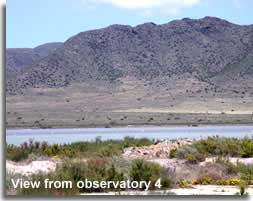 I have visited Las Salinas three times now, in January, June and August, I do not profess to be a bird watcher but I can appreciate nature and to see the birds in their natural habitat is quite a special experience. The observatories do give a really close up view and some of the birds can be just a few feet away.
I have visited Las Salinas three times now, in January, June and August, I do not profess to be a bird watcher but I can appreciate nature and to see the birds in their natural habitat is quite a special experience. The observatories do give a really close up view and some of the birds can be just a few feet away.
I took many photos, though the images I captured are in no way representative of the experience, therefore I can only recommend, to enjoy the bird life to its full potential, you pay a visit yourself, you will not be disappointed.
Bird spotting on the Cabo de Gata walking trails
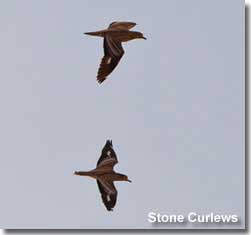 While Las Salinas is the main area for bird watching in the Cabo de Gata, and the natural park as a whole is home to many different species, there are great opportunities to spot certain birds along some of the signposted walking trails.
While Las Salinas is the main area for bird watching in the Cabo de Gata, and the natural park as a whole is home to many different species, there are great opportunities to spot certain birds along some of the signposted walking trails.
The San Pedro - El Plomo - Agua Amarga route
A variety of seabirds can be spotted along the rocky cliffs, the most common species is the Yellow-legged Gull, the route also passes one of the best conserved plant landscapes in the natural park, where bushes provide shelter for species such as the Black-bellied Sand Grouse, Stone Curlews, and the rare Dupont's Lark.
The Rio Alias river walk
A chance to spot Sparrowhawks, Harriers, and the great hunter, Bonelli's Eagle.
The El Pocico - Las Marinas coastal route
The inner the lagoons, close to the beach at Playa del Charcon, are visited by the migrating Greater Flamingo.
The Las Amoladeras nature walk
The coastal steppe provides plenty of bird spotting opportunities.
Walking trails of the Cabo de Gata natural park ![]()
The Cabo de Gata Natural Park is not only a dream location for bird spotting in Almeria, an area of outstanding natural beauty, it incorporates several traditional villages, numerous isolated beaches and coves, a marine reserve and features particular places of cultural interest.
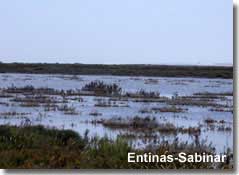
Bird watching Punta Entinas-Sabinar
The fifteen kilometre stretch of coastline between Almerimar in the municipality of El Ejido and the southern most point of Roquetas de Mar is a special zone of environmental protection, behind the beach, an area of sand dunes intermixed with wetland areas of freshwater and saline lakes is home to a wealth of bird life, wildlife and flora. 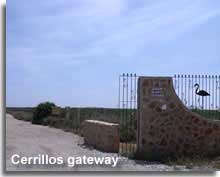 The Punta Entinas - Sabinar Nature Reserve begins at the eastern limit of the Almerimar beach and urbanised zone, at the Entinas gateway, the sand dunes down to the beach offer sights of colonies of the Audouin's Gull. There is a signposted walking route incorporating the Entinas area of the reserve which is also starts close to the gateway to the natural area just outside of Almerimar.
The Punta Entinas - Sabinar Nature Reserve begins at the eastern limit of the Almerimar beach and urbanised zone, at the Entinas gateway, the sand dunes down to the beach offer sights of colonies of the Audouin's Gull. There is a signposted walking route incorporating the Entinas area of the reserve which is also starts close to the gateway to the natural area just outside of Almerimar.
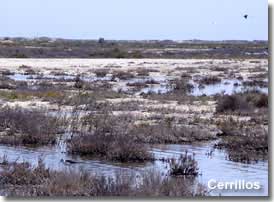
A second signposted walking trail, Salinas de Cerrillo, which begins at the opposite end of the protected zone, incorporates the abandoned salt pans of Cerrillos, the marshy habitats attracting numerous species of birds including the Greater Flamingo, Little Egrets, Avocets, the Northern Shoveller and the Grey Heron. The two routes effectively contrived to best appreciate these natural areas. 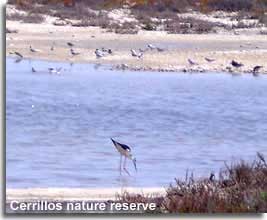 I was more than impressed with the opportunities for bird spotting along this route, I am not particularly bird savvy, but I saw many different species up close, and it was absolutely fascinating to be in such a natural place with the birds all around me. A very special and highly recommended destination for nature lovers, even if you aren't an expert.
I was more than impressed with the opportunities for bird spotting along this route, I am not particularly bird savvy, but I saw many different species up close, and it was absolutely fascinating to be in such a natural place with the birds all around me. A very special and highly recommended destination for nature lovers, even if you aren't an expert.
Walking trails in the Entinas - Sabinar nature reserve ![]()
External link
Provided to help visitors make the most of the area. The link will open in a separate page.
Information on Punta Entinas-Sabinar wetland area from the Junta de Andalucia
Bird watching Albufera de Adra 
A further wetland area for bird spotting in Almeria is the Albufera reserve in the municipality of Adra, detailed on the Junta de Andalucia website, the link of which is provided below.
External link
Provided to help visitors make the most of the area. The link will open in a separate page.
Information on the Albufera reserve from the Junta de Andalucia







